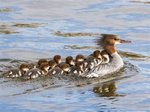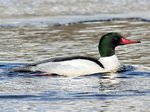

.png.jpg)
Three species of mergansers are fairly common in Thurston County. These are fish-eating diving ducks with long thin bills with a, hooked tip and saw-tooth edges (hence their old-fashioned name, saw-bills). Other than these shared characteristics, they are each quite different from the other.
Common Merganser
These are the largest of the mergansers at 24 inches (larger than a crow). They breed locally, primarily with nests found on gravel bars along the larger rivers. In summer, we see groups of nestlings along the Nisqually River, some quite large, being escorted by females as they slowly migrate downstream. By the end of August, these young have gained flight, but many of them remain in the Nisqually Delta. They are basically non-migratory, living their whole lives here locally.
The females and yearlings have gray bodies and rusty red heads. The bills of mature females become bright red at breeding time in the late winter, and their heads grow breeding plumes and look shaggy.
Males look entirely different from females and first-year young and resemble some other diving ducks. However, they are larger and without any head markings. They are starkly white at the waterline with a black back, a dark greenish head, and a bold red bill. In fall and winter you might see Common Mergansers sitting on Puget Sound mud flats and occasionally on inland lakes.
Hooded Merganser
This species is much smaller than the Common Merganser, and although it also breeds locally, it has a very different breeding pattern. Females nest in cavities and adapt well to using wood duck boxes. Nesting territories are usually small to medium-sized freshwater ponds and wetlands. Once breeding has begun, they can be quite secretive until the young leave the nest cavity. Then, like most ducks, the female can be seen leading her brood around the pond in a single file line. (This species shares a similar habitat to the Wood Duck, a species we will review in a future column).
The male Hooded Merganser is thought by many to be the most handsome of the ducks. He has a black head, a dramatic puffy black and white crest, yellow eyes, and a small black bill. He has a white breast, black body with white plumes, and rusty sides. Males can raise and lower their crests as part of a breeding display. Females are much less colorful, appearing brownish gray. They also have crests, and their spiky head can at times, seem quite comical.
In winter Hooded Mergansers are more often found in shallow marine water, typically in backwater coves. In fall and early winter, they are usually in small flocks. Mating displays begin in mid-winter, and soon they will be paired and ready for the breeding season.
Red-breasted Merganser
This third merganser species is about crow-sized, intermediate between the other two species, and has a completely different seasonal pattern. Red-breasted Mergansers are highly migratory, nesting in the extreme north of North America in those distant lakes and wetlands that freeze in the winter. They head south after breeding and spend the winter all along the west coast, including in southern Puget Sound, where they are usually seen only in marine waters.
These birds are long and slim and always have a shaggy crest on their heads. As with the other two species, the male is the more dramatic of the two sexes. He has a white neckband between his greenish head, reddish bill, and rusty brown breast. He appears gray at the waterline with a black body.
The female appears gray with a brownish head and may also have a reddish bill. In flight, both sexes have bold white patches on the trailing edge of the wing, a good field marker.
George Walter is an environmental program manager at the Nisqually Indian Tribe’s natural resources department; he also has a 40+ year interest in bird watching. He may be reached at george@theJOLTnews.com.
Photos for this column are provided by Liam Hutcheson, a 15-year-old Olympia area birder, and avid photographer.
Comments
No comments on this item Please log in to comment by clicking here